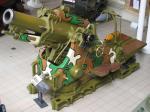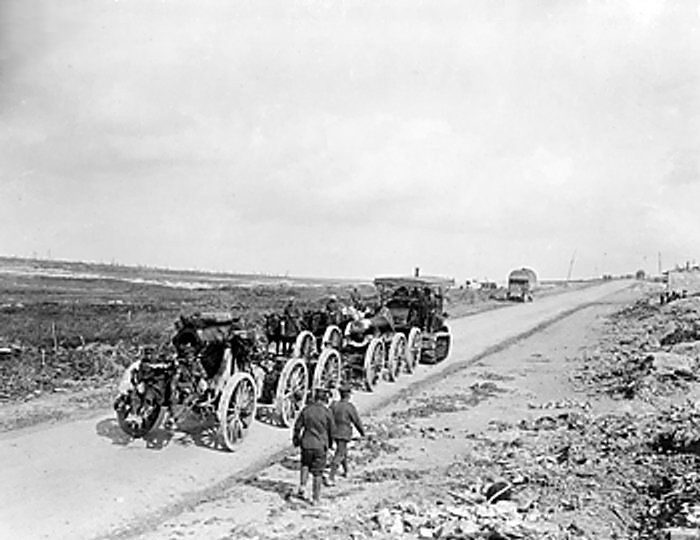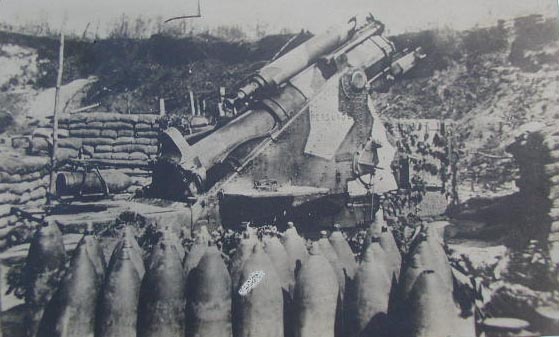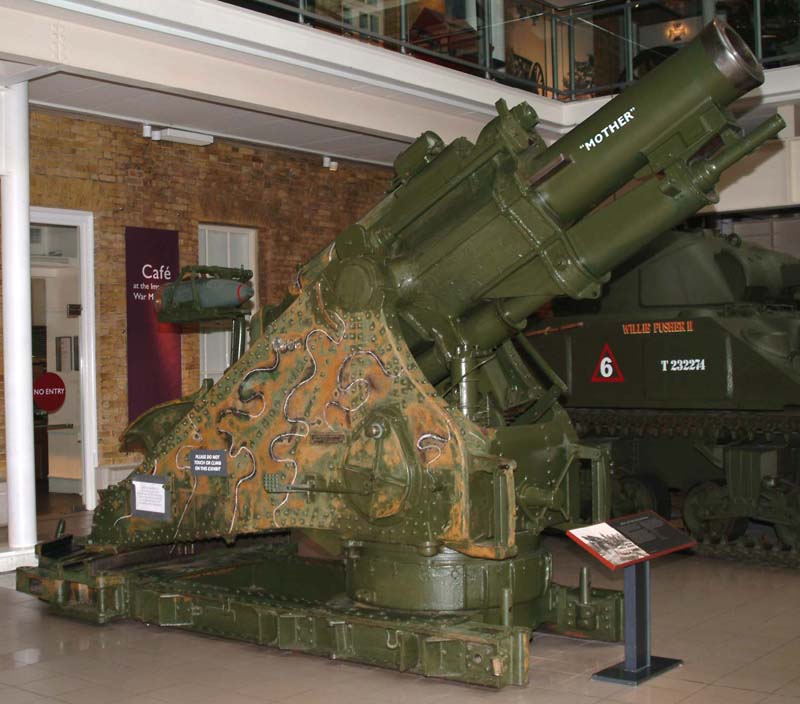
|
||||||||||||||||||||||||||||||||||||||||||||||||||||||
 Le B. L.9 inch Mark I et II.
Cette arme a été conçue pour remplacer le BL 6 inch. Mais à l'origine la pièce qui aurait dû remplacer le 6inch aurait dû être un engin de 8 inch
Autre photoscope ( Other WaklAround ) 1 Hotwizer B. L.9 inch Mark I and II.
The British heavy artillery in 1914 was attached to the campaign artillery This siege artillery for the tonnage of these pieces should be moved in several burdens She requires enormous movement like as run a gun out or in battery in battery for example Also for a movement war , the siege artillery appair like an anachronism a dinosaur.
But all this will change with the apparition of the mechanization. Indeed mechanization makes its place and its letters of nobility to this gun category on the battlefield Through it the power of the siege artillery will be able to play fully She will be transformed in heavy artillery and even super heavy and the coronation will be complete after WW1 when an howitzer of heavy artillery was chosen to sit on Monument Dedicated to the Royal Artillery Memorial in London facing Hyde Park Corner.
Heavy Artillery
During the nineteenth we should not talk about heavy artillery but siege artillery, which was attached to the Royal Garrison Artillery.
In 1889 is being put in place a new organization of the RA (Royal Artillery) It was divided into RHA (Royal Horse Artillery) RFA (Royal Field Artillery) RGA (Royal Garrison Artillery) This division was maintained until 1924 In this new organizational officers rarely chose the RGA as career opportunities in this division weapon were lesser . Indeed, the projection theatres external operations were rares thus the promotions also The RGA was deployed overseas in 1890/91 during the Boer War, but not this deployment left no trace of glorious action. The tactics of the movement war of this conflict could not be applied to this type of weapon But to make it more mobile various solutions have been explored The problem of the guns with a lightening of the gun by the adopting a new type of weapon the 4.7 inch gun equipped with the system Q. F (Quick Fire) Adoption of a barrel for the Navy of the same size as the previous one.
Tactics
In 1903 the first was created the first heavy artillery brigade made up of three companies with headquarters rettool with 4.7 inch guns
This first creation was followed in 1904 by a second brigade, with an amendment, however, the 4.7 inch of this new unit were replaced by 60 pdr BL (Breech Loading) The object of the creation of this brigade was to increase the mobility of artillery pieces and especially the efficacy. Indeed, the Russo-Japanese War of 1905 had hanged awareness of the need for effective siege artillery but also mobile The concept of heavy battery was put to sleep It was decided to test this new tactic in a powerful protecting British fort in 1907. Fort Chatham protect the naval base located in Kent in front of Dieppe . He was subjected to a serious attack with employ of new weapons (observation balloons, projector, new guns, telephone links between the different batteries) The result was conclusive and chapter headquarters manual tactic 1905 (Combined training) was replaced in 1909 by Field Service Regulation The artillery brigade headquarters 1902 1914. The Artillery siege Brigade was reformed in 1903.. For the formations of this new unit, it was necessary to detach some unites to complement it The basic structure of this unit was 2 artillery brigades The Medium Brigade made up of 4 batteries 4 to 6 inch pieces The Heavy Brigade, made up of 2 to 4 batteries 8.5 inch pieces (the staff is provided by the coastal artillery But faced with the lack of equipment 8.5 inch which never exceeded the table drawing equipment 8.5 inch was replaced by Skoda Mde 4 canon 1898 of 9.45 inch (240mm) secretly acquired during the Boer War To this unit must also add an Indian Army unit strong 2 companies 6.25 inch (parts similar to the 6.3 inch of the metropolis) The absence of conscription fact that the teams are composed of soldiers recalled in activity
The First World War.
The mobilization plans stipulate that the 3 siege companies turns into 6 batteries of siege
The demand for this type of batteries that fit in the Somme offensive of no less than 100 siege batteries were available especially thanks in part to the appeal of Lord Kitchtener who managed to beat the recall of 2.6 million volunteers Between 1914 1918 the number of heavy batteries was increased from 32 to 117 and there were also 402 siege batteries that were armed by British personnel, but it should to raise one’s hat to somebody to the mens from the Commonwealth, the British Empire and the Royal Marine Artillery (RMA) British army began the conflict with weapons having fought during the Boer War and whose design dates back to the last century, as the 6 inch The pull of these pieces is the beginning of the century until exclusively animal and must await the end of the Boer War to see a timid engine through steam vehicles (Steam Sapper) It was only in 1912 that we are seeing the first truly motorized vehicles .. The conditions or the figths on French theatre quickly revealed the limits of animal traction and the need for a mechanised artillery hence on the urgency it was purchase Carterpillar tracked vehicle. We find transformation of obsolete armoured tractors in SPG (self propelled Guns ) which were the transformation of Mark I chassis under the name of Gun Barrel Carrier with BL 6 inch. The end of the war is not yet the end of the horse traction in the British army, but the process is running. 
The B. L.9 inch Mark I and II.
This weapon was developed to replace the 6 inch BL. But the original piece that should have been replacing the 6inch should have been one unit of 8 inch
Face at the abandonment of the program the General Staff merely four Skoda guns secretly acquired during the Boer War, but the utilisation of this guns was unsatisfactory News tests are conducted with marine artillery pieces as RML 10 inch and who also has not been conclusive in the tests. In 1913 the prototype of a new gun was built at the Coventry Ordnance Works factory . This piece was designed taking into account all the faults and qualities of existing gear It had focused on mobility as the howitzer could be transported to several burdens craft was admirably designed and conceived
He was also placed on a gun carriage in iron beams to a good use, and it also had a good spring recuperator system. In July 1914 the tests were conducted and the tests were conclusive A laudatory report was established on August 3, 1914
Known as Mother he was sent to France in October 1914 and 16 were immediately ordered materials but they could not go into action only in March 1915 at the Battle of Neuve Chapelle. This piece had a total weight of 15.5 tons and had to be transported by 3 burdens. Before this gun was placed in a box containing iron 3 tons of backfill to cushion the movement of the piece during the firing and prevent it from the kind of lookout. To be operational, it was 12 hours of work and we make an excavation (11 tons of earth. ) Despite this he still participated to the campaign in France
He was built on an enhanced version Mark II, which had a range of 13 km, while the Mark I was pulling a shell de132 kgs at 9 Kms
But all was penalized by an overweight than 3 t.
The difference between the two machines was most visible at the tube, in fact, the MarkII had a tube much longer than the Mark I. 512 confused type machines were built and 62 were delivered to the Allies. These devices remained in service until the beginning of the second war mondiale1940 where 16 copies fell in the hands of the Germans who used it as instructional material under the name Haubitze 546 (e).
Camouflage
The camouflage used by all belligerants during WW1
It was different and colorful. But armies are entering into campaign with little camouflage For English troops the color of the artillery was the Khaki (light green Browny) But the imperatives of the conflict that quickly camouflage was applied to the equipment and we get quite complex of camouflages where the yolk alongside the emerald green brown. Each color is defined by a fine black net. It should be noted, however, that all mobile systems were never painted remainder of the color metal
Technical Data
Features Mark II
Calibre: 234 mm L/17 Weight 16.5 t Weight tube 4 .. 4t Weight 131.54 kg projectile Mark I Scope 9.3 km Mark II 12.7 kms V ° projectile 488 m / s
|
|
Droit d’auteur La plupart des photographies publiées sur ce site sont la propriété exclusive de © Claude Balmefrezol Elles peuvent être reproduites pour une utilisation personnelle, mais l’autorisation préalable de leur auteur est nécessaire pour être exploitées dans un autre cadre (site web publications etc) Les sources des autres documents et illustrations sont mentionnées quand elles sont connues. Si une de ces pièces est protégée et que sa présence dans ces pages pose problème, elle sera retirée sur simple demande. Principaux Collaborateurs:
Nb
de visiteurs:8808918 Nb
de visiteurs aujourd'hui:405 Nb
de connectés:44
| ||||||||||||||||||||||||||||||||||||||||||||||||||||





















